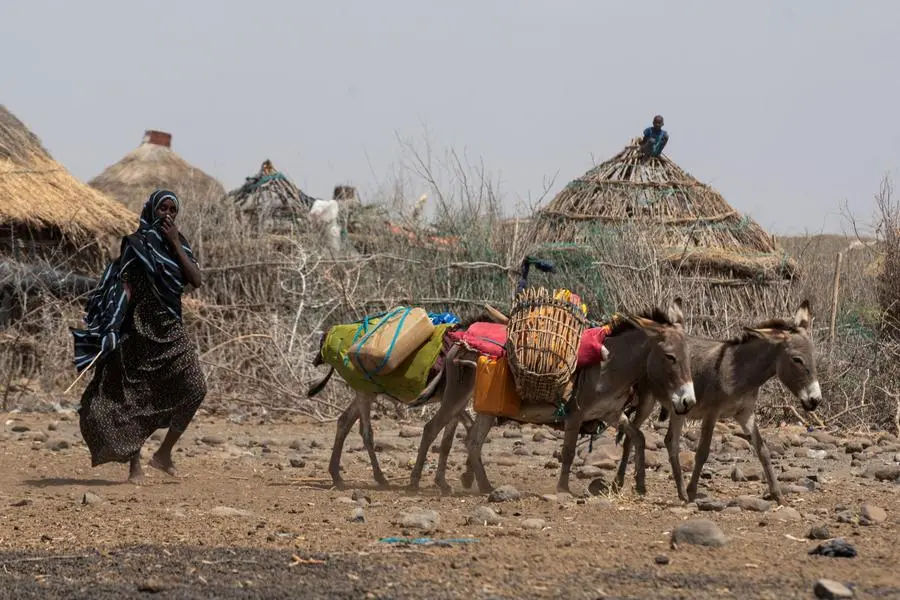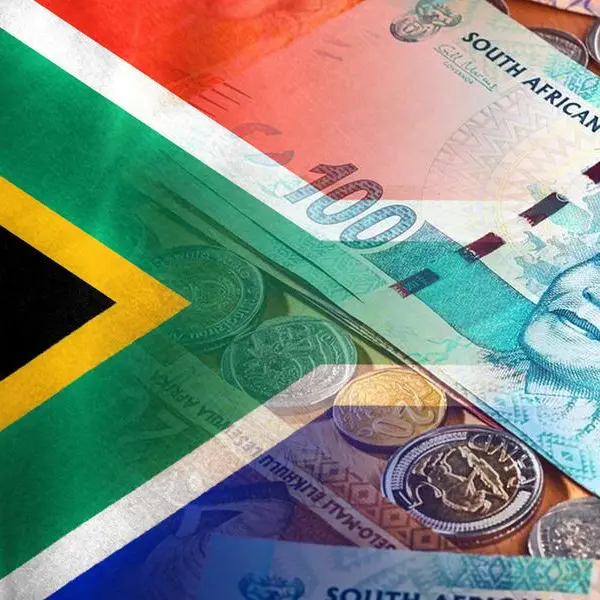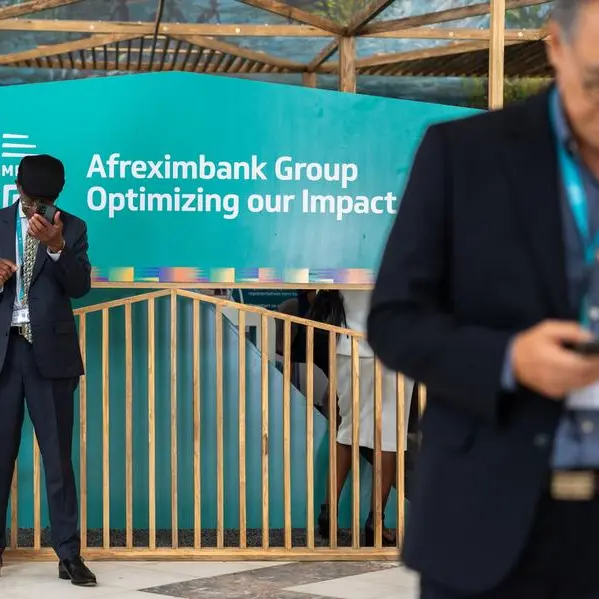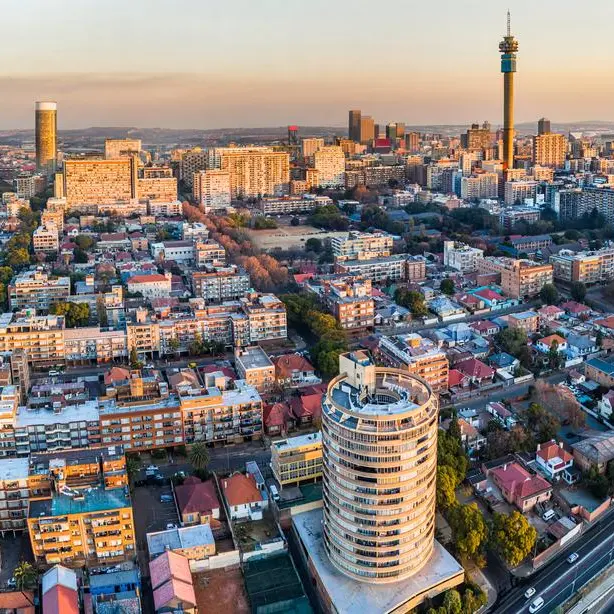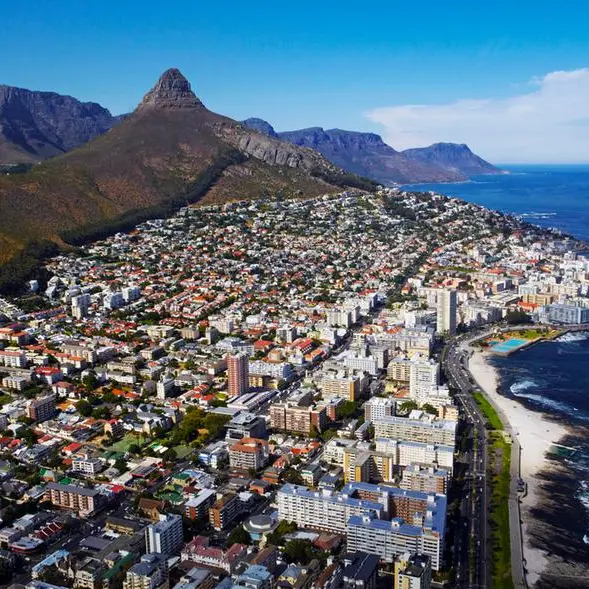PHOTO
MOGADISHU - In October, Nadifa Abdi Isak brought her malnourished daughters to hospital in Mogadishu. That day, a nurse said, 42 other children had already been checked into the emergency unit, ravaged by hunger. There were 57 the day before that.
Staff at the Benadir maternity and paediatric hospital said admissions of malnourished children have more than doubled their patient numbers over the past year. They are now treating over 1,000 emergency cases each month.
Half a million children's lives are at risk from a looming famine in Somalia, according to the United Nations – that's more than in any country worldwide this century.
Across Africa, from east to west, people are experiencing a food crisis that is bigger and more complex than the continent has ever seen, say diplomats and humanitarian workers.
One in five Africans – a record 278 million people – were already facing hunger in 2021, according to data from the U.N. Food and Agriculture Organization (FAO). It says the situation has worsened.
The number of East Africans experiencing acute food insecurity – when a lack of food puts lives or livelihoods in immediate danger – has spiked by 60% in just the last year, and by nearly 40% in West Africa, according to the World Food Programme (WFP).
Conflict and climate change are the long-term causes. Heavy debt burdens following the COVID-19 pandemic, rising prices and war in Ukraine have made things much worse as European aid has been sucked away, data and testimony from more than a dozen experts, donors, diplomats, medical staff and men and women in farms and marketplaces across nearly a dozen countries in Africa and beyond shows.
Benadir Hospital is coping, said Dr. Aweis Olow, head of its paediatric department. But referrals from other clinics are accelerating: "Without a lot of help from the rest of the world, the situation will be out of control."
Here, alongside Isak's story, are five reasons Africa is suffering from the worst food crisis ever recorded:
1. CLIMATE CHANGE
East Africa has missed four consecutive rainy seasons, the worst drought in 40 years, Michael Dunford, the WFP's East Africa director said.
"The situation has never been as bad from a regional perspective as it is today," he told Reuters.
African countries account for only around 3% of the global emissions responsible for climate change, but suffer more than any other region from its impact.
Of the 20 nations ranked as most vulnerable to climate change, all but four are African, according to the Notre Dame Global Adaptation Index, which measures countries' vulnerability.
Some 22 million people across Ethiopia, Kenya and Somalia face high levels of acute food insecurity due solely to the drought, a number projected to rise to up to 26 million by February if the rains again fail, the WFP said.
The lack of rainfall has caused crops to fail. In northern Kenya, pastoralists dig deeper and deeper in search of water for their livestock. Traditional Maasai herders, whose culture revolves around their cows, face the choice of selling them or watching them die.
On the other side of the continent, parts of West Africa have been hit by flooding after the most intense rainfall in 30 years. By mid-October, 5 million people and 1 million hectares of farmland were affected, according to the WFP.
In Chad, over 19,000 head of livestock were swept away after rivers broke their banks, and in neighbouring Nigeria, flooding has hit 29 of the 36 states.
In October in Benue state, part of Nigeria's agricultural heartland, farmer Abraham Hon looked out over water stretching to the horizon, covering some 20 hectares of his ruined rice fields.
"You have drought in some places, then you have floods in some places," he said. "That is a real shift."
"SAVING OUR CHILDREN"
Isak's hometown, Dinsoor, is about 370 km (230 miles) from the capital in Somalia's Bay region. In June, she and her husband and children set out on foot, hoping to escape drought. The journey to Mogadishu took 12 days.
They brought their savings of around $15, and some milk and food.
They walked. "We fled in the hope of saving our children," she said, seated on a hospital bed with her two girls – Nasib, 4, and Fardawsa, 3 – and an infant on her back.
A day into the journey, they were ambushed by bandits. The robbers took their money and food, but spared their lives. They kept walking. A stranger gave the children a lift on his donkey cart.
After four days they reached the regional capital, Baidoa, but couldn't find help there. Someone gave them a lift to Mogadishu. There, they found a spot on government land and built a shelter with other displaced people.
Mohamud Abdi Ahmed, an official for the Garasbaley district where the family set up camp, said there were 50,000 displaced families there.
"Sometimes it's difficult to count them, because more arrive every minute."
2: CONFLICT IN AFRICA
Conflict has long been a driver of hunger. War forces civilians from their homes, livelihoods, farms and food sources. It also makes it dangerous to deliver assistance.
The number of displaced people in Africa has tripled over the past decade to a record 36 million in 2022, according to U.N. data. That represents almost half the displaced people in the world. Most were displaced internally within their own countries by conflict.
Conflicts are worsening across the continent, according to the Armed Conflict Location & Event Data Project (ACLED), a crisis monitoring group.
In 2016, it recorded 3,682 "battles" between armed groups in Africa. There were 7,418 in 2021.
Isak's country, Somalia, has been unstable since a civil war in the early 1990s and today is a patchwork of clan strongholds, government-controlled areas and zones in the grip of al Shabaab, an al Qaeda-linked militant group fighting to impose its own rule based on a strict interpretation of Islamic Sharia law.
A U.S. non-profit, Fund for Peace, ranks global states by how fragile they are. In 2022, 15 African nations occupied the top 20 slots of its rankings.
SUFFOCATION
Whenever Isak had food, her youngest children were given top priority.
"The children were getting weaker for months," she said. She and other mothers say malnourished children swell up and their skin thins. They bruise easily.
Just a week after the family arrived in Mogadishu in June, two of Isak's daughters - 6-year-old Muna and 7-year-old Hamdi - fell ill one after another.
They were weak and ran fevers, their legs bowed and limbs swelled. They began to cough and struggled to breathe.
People who don't get enough minerals or vitamins can develop iron-deficiency anaemia, which means they do not have enough healthy red blood cells to carry oxygen to tissues throughout the body.
So as children starve, their bodies slowly suffocate.
Dr Olow said such cases are becoming commonplace. Children arriving at Benadir Hospital receive oxygen, emergency feeding and, if needed, blood transfusions. Just 3% die, Olow said.
By the time Isak brought Muna and Hamdi for treatment, it was too late.
"The doctors could not help them, because they were about to die when we reached the hospital," Isak said.
3. CONFLICT IN EUROPE
Russia's invasion of Ukraine in February, which Moscow calls a "special military operation," added to Africa's problems.
The crisis distracted wealthy governments' humanitarian agencies for the first half of this year, said a senior Western government official involved in humanitarian response in Africa, who asked not to be named because he was not authorised to speak to the media.
"When Ukraine happened, it sucked all the oxygen out of the room," he said.
As the food crisis deepened earlier this year, the African Development Bank set up an emergency food production fund of $1.5 billion aimed at helping African farmers produce 38 million tonnes of wheat, corn, rice and soybeans.
But needs across Africa's crises have risen by 13% over the past year alone, the data shows. While total donor funding over that time has increased 12%, it currently meets just half of requirements.
European countries in particular have cut aid in Africa. European governments contributed 21% of humanitarian relief aid to African countries in 2022, down 16 percentage points since 2018.
Some countries – such as the United States – have since boosted humanitarian assistance budgets, but the shortfalls remain, a Reuters analysis of U.N. data shows.
Four of the five African countries receiving the most humanitarian funding under the 2022 aid appeal are located in or border the drought-stricken Horn of Africa region.
That's leading to some tough choices.
The WFP has, in some cases, been forced to reduce rations, said Ollo Sib, a senior researcher for the agency in West Africa.
"We can keep people alive, but we don't just want to keep people alive," he said.
Chad, for example, currently hosts 577,000 refugees from other countries – the largest group in West Africa. Since 2020, conflict there has also more than doubled the number of internally displaced Chadians to around 381,000.
Faced with overwhelming needs, the WFP has already begun reducing rations for some refugees. And it told Reuters that, without more funding soon, it could be forced to suspend food assistance for all but the 10% of refugees considered the most vulnerable.
Moscow's Ukraine campaign also throttled grain exports.
The U.N. and Turkey brokered a deal in July to unblock three Black Sea ports. Under that initiative, 615 vessels left Ukrainian ports between Aug. 1 and Dec. 13 carrying over 13.8 million tonnes of corn, wheat, rapeseed and sunflower oil.
Just 11 ships were destined for sub-Saharan Africa, however.
"It's making a contribution. But there is no silver bullet," said the WFP's Dunford.
Disruptions caused by that war have also provoked a fertiliser shortage. Where stocks are available, prices have risen beyond the means of many farmers. The result will be smaller harvests next year: In West Africa, the WFP estimates cereal production could fall 20%.
"THEY DON'T KNOW THEY'RE DEAD"
The Benadir hospital can't always help.
"Sometimes mothers bring us dead children," said Farhia Moahmud Jama, head nurse at the paediatric emergency unit. "And they don't know they're dead."
Weakened by hunger, camp residents are vulnerable to disease and people are dying due to a lack of food, said Nadifa Hussein Mohamed, who managed the camp where Isak's family initially stayed.
"Maybe the whole world is hungry and donors are bankrupt, I don't know," she said. "But we're calling out for help, and we do not see relief."
Isak and her husband said some nights, armed men threaten and beat the residents: "They want to sell the land."
Ahmed, the district official, said security around the camps was tight.
4. DEBT
COVID-19 left Africa facing the strongest economic headwinds in years, according to the International Monetary Fund (IMF).
After years of borrowing, countries are struggling to service their debts. According to the IMF, 19 of sub-Saharan Africa's 35 low-income countries are in debt distress – where a government is unable to fulfil its financial obligations and debt restructuring is required – or at high risk of it.
Ghana is an example. The country of 32 million people owed 476 billion cedis – or around $42 billion in September – over $1,300 per person. In July, the government turned to the IMF for relief. In December, Finance Minister Ken Ofori-Atta said debt had topped 100% of Ghana's Gross Domestic Product.
Ghana's currency, the cedi, is Africa's weakest. At its lowest level this year, in November, it sank by 59% against the dollar, straining the country's ability to pay for imports. Shopkeepers shut their doors temporarily in October in protest.
In October, Ghana's inflation rate hit a new 21-year high of 40.4%, driven in large part by higher food costs. Cereal prices have gone up over 51%. Dairy and eggs by nearly 59%.
Globally, prices of cereals, dairy, meat, vegetable oils and sugar climbed over 23% in 2021, the fastest in more than a decade, according to an index from the FAO.
Food expenses constitute 40% of households' consumer spending in sub-Saharan Africa – the highest share in the world, according to the IMF.
For Ghanaian Evelyn Lartey, a trip to market in the capital Accra has become a race.
"The maths you use one day expires the next, and you don't know what are the real prices," she said. "You just have to pay what you're told or else keep walking."
HEART PAIN
On Wednesday Oct. 19, months after Muna and Hamdi's deaths, two of Isak's other daughters – Nasib and Fardawsa – could not sleep.
"They were complaining of heart pain. It was 2 a.m.," she said.
They set off for the hospital. There were few vehicles on the road, and none stopped when they tried to wave them down, so Isak and her husband carried the children for four km.
A normal three-year-old child has between 11 and 13.7 grams of haemoglobin, the iron-rich protein that carries oxygen around the body, per decilitre of blood.
Doctors told Isak that Fardawsa's blood contained 1 gram of haemoglobin per decilitre. She needed a blood transfusion.
The medics couldn't find a vein on her hands, so they transfused the blood through a vein in her head.
"It's not yet her time to die," her mother said, relieved.
5. GOVERNMENTS
African governments have done little to prevent food crises from recurring.
In a move to boost production, reduce import reliance and improve food security, leaders in 2003 pledged to commit at least 10% of their national budgets to agriculture and rural development within five years.
By 2021, nearly two decades later, just two countries in sub-Saharan Africa – Mali and Zimbabwe – met that target.
Instead, an analysis of 39 African countries by UK charity Oxfam found, spending on agriculture fell as a share of budgets between 2019 and 2021.
Agriculture makes up nearly 20% of Africa's GDP and more than half of Africans work in the sector, according to the World Bank. Most of this is low-productivity subsistence farming, and the region is a net importer of staples including wheat, palm oil and rice, the FAO says.
Productivity and crop yields have increased, but they are still the lowest in the world and the FAO says they come nowhere close to keeping up with the continent's growing population, which the U.N. forecasts will more than triple to 4.3 billion by the end of the century.
So agricultural production per capita is falling, according to the FAO.
Self-sufficiency for major food commodities is decreasing. Without action, the World Bank says Africa's food import bill, which stood at $43 billion in 2019, could rise to $110 billion in 2025.
"We have 65% of the world's available arable land. We have to wake up," Akinwumi Adesina, president of the African Development Bank, told Reuters. "For me, the bare minimum is that Africa is able to feed itself."
"STRENGTH, BUT NO WORK"
Nasib and Fardawsa spent a week in the hospital, receiving blood transfusions, medicine and nutritional biscuits. They recovered, but then Isak's four-month-old, Farhan, needed care.
He received an emergency transfusion and treatment. The doctor prescribed syrups and supplementary iron tablets that the family cannot afford.
"I don't have any money," she said.
In search of aid and security, in November the family moved onto an abandoned military camp closer to the city centre.
They are no longer harassed, but attacks by Islamist militants periodically send the city into lock-down. Isak's husband, Mohamed Ibrahim, hoped he could earn money for food in town, working as a porter.
"I have strength but no work. I have a wooden wheelbarrow," he said. But most people use the services of tuk-tuks instead.
After months on the move – from her village to the city, from camp to camp, and hospital to hospital – Isak is running out of energy. She believes she herself and two other children are now also anaemic.
"If he gets a dollar or two, this is not even enough for food for the children."
(Additional reporting by Ayenat Mersie and Katharine Houreld in Nairobi, Cooper Inveen in Accra, Libby George and Abraham Achirga in Lagos, Loucoumane Coulibaly in Abidjan and Nancy Lapid in New York Edited by Sara Ledwith, Jon McClure and Daniel Flynn)
